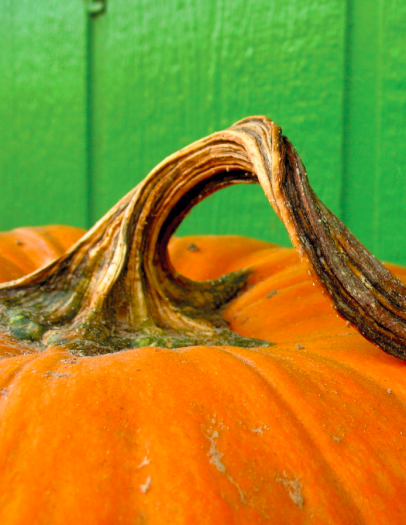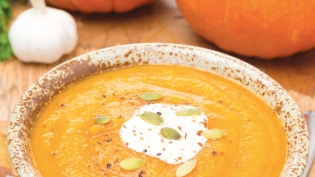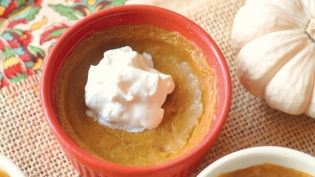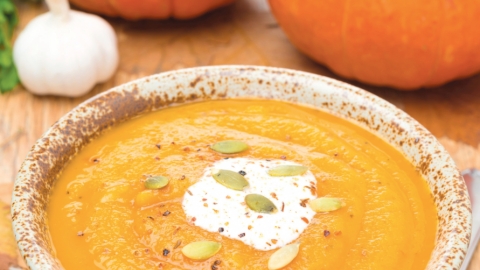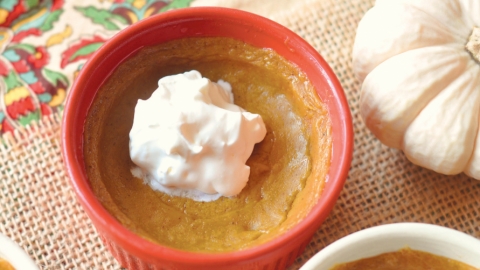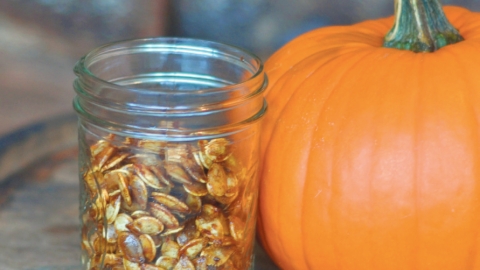In Season: Pumpkins
Fall arrives subtly here in our coastal climate; temperatures drop only ever so slightly and few leaves change in color. However, a trip to any local farmers’ market offers those sought-after signature hues of the season, with piles of pumpkins blazing in autumnal shades of orange and gold. In fact, these gourd-like squashes can now be found in an array of earthy colors, with edible heirloom varieties boasting tones of dusty blue, deep green, pure white, and even salmon-pink!
Beyond their decorative value, long-storing heirloom pumpkins are culinary delights, lending themselves to all sorts of fall and winter recipes. Their thicker walls yield more flesh and a richer taste than traditional carving pumpkins. And they pack a nutritional punch with plenty of fiber, protein, and vitamins A and C. Here are a few tips on how to pick, prep, and cook these fruits of the season.
PICK A PERFECT PUMPKIN
Look for a pumpkin that is firm with no bruises or soft spots. The variety you select can depend on how you plan to serve the squash, or simply choose one that piques your interest and then determine its best culinary use.
CUTTING & PEELING A PUMPKIN
For many, the experience of cutting a pumpkin starts and ends with carving jack-o-lanterns, making the idea of working with heirloom varieties in the kitchen a bit daunting. Start with a sharp chef ’s knife and follow these easy steps:
- Wash the pumpkin in cool water to remove any dirt. Pat dry.
- Remove the stem by inserting the tip of your knife at a 45˚angle into the top of the pumpkin, about 2 inches from the stem, and cutting a circle all the way around the stem and through the flesh.
- Cut the pumpkin in half vertically and scoop out the seeds and pulp with a spoon. (Save the seeds for roasting, if desired. See instructions and recipe below.)
- To peel, cut the pumpkin halves into manageable 1- to 2-inch chunks or slices. Lay the cut pieces flesh side up on a cuttingboard and slide your knife between the shell and the flesh, cutting away the outer rind.
COOKING A PUMPKIN
There are several ways to cook a pumpkin. For purée, follow steps 1 through 3 in “Cutting & Peeling a Pumpkin,” above; for peeled, cooked pumpkin pieces, follow steps 1 through 4. Then, choose any cooking method below.
- Bake – Heat oven to 350˚. Place the cut pumpkin in a baking pan filled with about 1 inch of hot water. Cover the dish with foil and bake until tender, about 45 minutes to 1 hour.
- Roast – Heat oven to 400˚. Arrange cut pumpkin in a single layer on a baking sheet. Drizzle with olive oil and roast until tender and golden, about 45 minutes to one hour.
- Steam – Place a steamer basket in the bottom of a large pot. Fill the pot with water to just below the level of the basket. Add pumpkin, cut to fit, to the steamer basket. Bring water to a boil; cover and cook for 20–30 minutes, or until soft.
SERVING PUMPKIN
If cooked in the shell, scoop out the cooked pumpkin flesh with a spoon. It can then be mashed or puréed for use in recipes that call for puréed pumpkin, such as baked goods, pies, custards, and soups. Peeled, cooked pumpkin pieces can be seasoned with salt and seasonal herbs for a delicious side dish, added to stews, or pureed.


